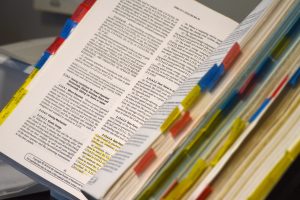16 Tests
Tested at every turn! Testing is a part of life. They alone are not good measurements about how smart or gifted you are—they show only how much you know or can do at that moment. We can learn from how we have performed, and we can think about how to apply what we have learned to do even better next time. We can have fun measuring our progress. Many of our daily activities are measurements of progress toward mastery of skills or knowledge. We welcome these opportunities as both work and fun. But when these opportunities are part of our academic life, we often dread them and rarely feel any sense of fun.

In reality, however, academic tests are similar to real-life tests in the following ways:
- They help us measure our progress toward mastery of a particular skill.
- They are not a representation of how smart, talented, or skilled we are but rather are a measurement only of what we know about a specific subject at a specific point in time.
- They are extraordinary learning opportunities.
Academic tests in college maybe different from those you took in other school settings. College professors expect to see much more of you in an exam: your thoughts, your interpretations, your thinking process, your conclusions. This is why you need to modify your study habits and your strategies for taking test in college.
Types of Tests
Strategies for different types of tests: each type has its own peculiar strategies:
Paper tests
Paper tests are still a very common type of test, requiring students to write answers on the test pages or in a separate test booklet. They are typically used for in-class tests. Neatness and good grammar count, even if it’s not an English test. Remember that the professor will be reading dozens of test papers and will not likely spend much time trying to figure out your hieroglyphics, arrows, and cross-outs.
Open-book tests

Open-book tests allow the student to consult their notes, textbook, or both while taking the test. Professors often give this type of test when they are more interested in seeing your thoughts and critical thinking than your memory power. Be prepared to expose and defend your own viewpoints. When preparing, know where key material is present in your book and notes. Create an index for your notes and use sticky notes to flag key pages of your textbook before the test. Be careful when copying information or formulas to your test answers, because nothing looks worse in an open-book test than misusing the material at your disposal.
Take-home tests
Take-home tests are like open-book tests except you have the luxury of time on your side. Make sure you submit the test on time. Know what the professor’s expectations are about the content of your answers. The professor will likely expect more detail and more complete work because you are not under a strict time limit and because you have access to reference materials. Be clear about when the test is due. Some professors will ask you to e-mail your test to them by a specific time. Also, find out if the professor allows or expects you to collaborate with classmates. Be sure to type your test and don’t forget to spellcheck!
Online tests
Online tests are most commonly used for formative assessments, although they are starting to find their way into high-stakes tests, particularly in large lecture classes that fulfill a graduation requirement. The main advantage of online tests is that they can be computer graded, providing fast feedback to the student and allowing the professor to grade hundreds of tests easily. Since these tests are computer graded, be aware that the professor’s judgment is not involved in the grading. Your answers will be either right or wrong; there is no room for partially correct responses. With online tests, be sure you understand the testing software. Are there practice questions? If so, make sure you use them. Find out if you will be allowed to move freely between test sections to go back and check your work or to complete questions you might have skipped. Some testing software does not allow you to return to sections once they are “submitted.” Unless your test needs to be taken at a specific time, don’t wait until the last minute to take the test. Should you have technical problems, you want to have time to resolve the issues. To avoid any conflicts with the testing software, close all other software applications before beginning the testing software.
The Secrets of the Q and A’s
You can gain even more confidence in your test-taking abilities by understanding the different kinds of questions a professor may ask and applying the following proven strategies for answering them. Most professors will likely use various conventional types of questions. Here are some tips for handling the most common types.
Multiple-Choice Questions
Read the instructions carefully to determine if there may be more than one right answer. If there are multiple right answers, does the professor expect you to choose just one, or do you need to mark all correct options?
- Read each question carefully and try to answer it in your head before reading the answer options. Then consider all the options.
- Eliminate first the options that are clearly incorrect.
- Read the questions and one of the options as a sentence and turn it into a True/False question.
- Look for clue words that hint that certain option answers might be correct or incorrect.
- Ensure the option you choose best matches what the question is asking.
True-or-False Questions
Answer the questions that are obvious to you first. Then go back to statements that require more thought. If the question is stated in the positive, restate it to yourself in the negative by adding the word “not” or “never.” Does the new statement sound truer or more false?
Short Answer Questions
Short answer questions are designed for you to recall and provide some very specific information: When you read the question, ask yourself what exactly the professor wants to know. Keep your answers short and specific.
Essay Questions
Essay questions are used by professors to evaluate your thinking and reasoning applied to the material covered in a course. Good essay answers are based on your thoughts, supported by examples from classes and reading assignments.
- Careful planning is critical to answering essay questions effectively. Note how many essay questions you have to answer and how difficult each question seems. Then allocate your time accordingly.
- Read the question carefully and underline or circle keywords. Watch for words that describe the professor’s expectations for your response.
- If time allows, organize your thoughts by creating a quick outline for your essay. This helps ensure that you don’t leave out key points, and if you run out of time, it may pick up a few points for your grade. Jot down specific information you might want to use, such as names, dates, and places.
- Introduce your essay answer, but get right to the point. Remember that the professor will be grading dozens of papers and avoid “filler” text that does not add value to your answer.
- Write in direct and concise statements.
- Write neatly and watch your grammar and spelling. Allow time to proofread your essay. You want your professor to want to read your essay, not dread it. Remember that grading essays is largely subjective, and a favorable impression can lead to more favorable grading.
- Be sure to answer all parts of the question. Essay questions often have more than one part. Remember, too, that essay questions often have multiple acceptable answers.
Strategies for Math Tests
Math tests require some special strategies because they are often problem based rather than question based.
Do the following before the test:
- Attend all classes and complete all assignments. Pay special attention to working on all assigned problems. After reviewing problems in class, take careful notes about what you did incorrectly. Repeat the problem and do a similar one as soon as possible. It is important that the last solution to a problem in your mind is a correct solution.

Image by Gerd Altmann from Pixabay - Think about how each problem solution might be applied in a real-world situation. This helps make even the most complex solutions relevant and easier to learn.
- In your study group, take turns presenting solutions to problems and observing and correcting everyone’s work.
- If you are having difficulty with a concept, get help right away. Remember that math especially builds new material on previous material, so if you are having trouble with a concept now, you are likely to have trouble going forward. Make an appointment with your professor. Don’t be shy about asking for a tutor—tutoring is not just for students needing remedial help; many successful students seek them out, too.
Do the following during the test:
Review the entire test before you start and work the problems you feel most confident with first.
Approach each problem following three distinct steps:
- Read the problem through twice: the first time to get the full concept of the question, and the second time to draw out pertinent information. After you read through the problem the first time, ask yourself, “What is this problem about?” and “What is the answer likely to look like?” The second time through, consider these questions: “What facts do I have available?” “What do I know?” “What measurable units must the answer be in?” Think about the operations and formulas you will need to use. Try to estimate a ballpark answer.
- Compute your answer. First, eliminate as many unknowns as possible. You may need to use a separate formula for each unknown. Use algebraic formulas as far as you can before plugging in actual numbers; that will make it easier to cancel and combine factors. Remember that you may need two or more tries before you come up with the answer.
- Check your work. Start by comparing your actual answer to the estimate you made when you first read the problem. Does your final answer sound likely? Check your arithmetic by opposite operations: use multiplication to check division and addition to check subtraction, and so on. You should consider using these three steps whenever you are working with any math problems, not just when you get problems on tests.
Strategies for Science Tests
Science tests also are often problem based, but they also generally use the scientific method. This is why science tests may require some specific strategies.
- Before the test, review your lab notes as well as your class notes and assignments. Many test questions build upon lab experience, so pay close attention to your notes, assignments, and labs. Practice describing the experimental process.
- Read the question carefully. What does the professor expect you to do? Prove a hypothesis? Describe an experiment? Summarize research? Underline the words that state the objective of the question.
- Look carefully at all the diagrams given with the question. What do they illustrate? Why are they included with the question? Are there elements on the diagram you are expected to label?
- Many science questions are based on the scientific method and experimental model. When you read the test question, identify the hypothesis the problem is proposing; be prepared to describe an experimental structure to prove a hypothesis. When you check your work, make sure the hypothesis, experimental steps, and a summary of results (or expected results) are clear. Some of these elements may be part of the question, while others you may need to provide in your answer.
Test Anxiety
Thought Activity: Testing Your Test Anxiety
Consider the following statements as if they were True/False Questions. There are no wrong answers.
T F I have a hard time starting to study for a exam.
T F When studying for an exam, I feel desperate or lost.
T F When studying for an exam, I often feel bored and tired.
T F I don’t sleep well the night before an exam.
T F My appetite changes the day of the exam. (I’m not hungry and skip meals or I overeat—especially high-sugar items like candy or ice cream.)
T F When taking an exam, I am often confused or suffer mental blocks.
T F When taking an exam, I feel panicky and my palms get sweaty.
T F I’m usually in a bad mood after taking an exam.
T F I usually score lower on exams than on papers, assignments, and projects.
T F After an exam, I can remember things I couldn’t recall during the exam.
If you answered true to any of the statements in the table above, you have suffered some of the symptoms of test anxiety. Most of us have experienced this.

It is normal to feel stress before an exam, and in fact, that may be a good thing. Stress motivates you to study and review, generates adrenaline to help sharpen your reflexes and focus while taking the exam, and may even help you remember some of the material you need. But suffering too many stress symptoms or suffering any of them severely will impede your ability to show what you have learned. Test anxiety is a psychological condition in which a person feels distress before, during, or after a test or exam to the point where stress causes poor performance. Anxiety during a test interferes with your ability to recall knowledge from memory as well as your ability to use higher-level thinking skills effectively.
There are steps you should take if you find that stress is getting in your way:
• Be prepared. A primary cause of test anxiety is not knowing the material. If you take good class and reading notes and review them regularly, this stressor should be greatly reduced if not eliminated. You should be confident going into your exam (but not overconfident).
• Make sure you eat well and get a good night’s sleep before the exam. Hunger, poor eating habits, energy drinks, and lack of sleep all contribute to test anxiety.
• Bounce bad vibes. Your own negative thoughts — “I’ll never pass this exam” or “I can’t figure this out, I must be really stupid!” — may move you into spiraling stress cycle that in itself causes enough anxiety to block your best efforts. When you feel you are brewing a storm of negative thoughts, stop what you are doing and clear your mind. Once your mind is clear, repeat a reasonable affirmation to yourself — “I know this stuff” — before continuing your work.
• It’s all about you! Don’t waste your time comparing yourself to other students in the class, especially during the exam. Keep focused on your own work and your own plan. Exams are not a race, so it doesn’t matter who turns in their paper first.
• Chill! You perform best when you are relaxed, so learn some relaxation exercises you can use during an exam. Before you begin your work, take a moment to listen to your body. Which muscles are tense? Move them slowly to relax them. Tense them and relax them. Exhale, then continue to exhale for a few more seconds until you feel that your lungs are empty. Inhale slowly through your nose and feel your rib cage expand as you do. This will help oxygenate your blood and reenergize your mind.
Test Taking Tips
Before the test:
- Learn as much as you can about the test.
- Try to foresee the questions likely to be on the test.
- Don’t be tempted to stay up late cramming.
- The night before, get some exercise, watch what you eat and get a good nights rest.
- Get to the test site early with all your tools
During the test:
- When you receive your test, scan the entire test first. Evaluate the importance of each section.Then create a time allocation plan.
- Write it down. Take a couple minutes to write down key facts, dates, principles, statistics, and formulas on a piece of scratch paper or in the margin of the test paper.
- Read the directions carefully.
- Do the easy questions first.
- Keep an eye on the time. Keep as close to your plan as possible.
- Check your work. Ensuring that you have complete answers according to the directions; then look for other common mistakes.
Key Takeaways
- Tests help use measure your progress but are not representations of how smart, talented or skilled you are; rather, they measure what you know as a specific point in time.
- Paper, open book, take-home and online tests require different study techniques to help you prepare.
- Multiple choice, true-or-false, short answer and essay questions are common types of questions you will encounter and each can be tackled differently using proven strategies.
- Math and science tests are problem based and require unique preparation.
- Test Anxiety can interfere with your ability to recall knowledge as well as use higher level thinking skills. Simple strategies such as being prepared, eating and sleeping well before the text, re-framing negative thoughts, and not paying attention to others can help. Often, relaxation techniques can help you minimized the effects of test anxiety. For significant test anxiety, visit a college counsellor for additional strategies.

